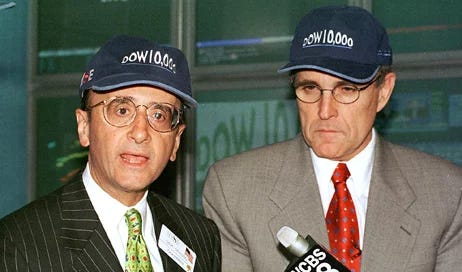On March 29, 1999 — 25 years ago today — the Dow Jones Industrial Average hit 10,000 for the first time in its entire history (the Dow was founded in 18961). Custom hats were made for the occasion and passed out on the trading floor of the New York Stock Exchange. NYSE Chairman Richard Grasso and New York City mayor Rudolph Giuliani wore those hats when they rang the closing bell. Last year I bought a reproduction that I wear on a regular basis — including, occasionally, around lower Manhattan, where, sadly, no one compliments me or even seems to know what it is.
Dow 10,000 made headlines, and was widely described in the business press as “a psychological milestone.” The 1990’s was basically one long bull market, and on the eve of the new millennium, the line graphs did what previously seemed impossible, even for that record-breaking decade. Much of that rise in stock values had to do with the brand new World Wide Web, which opened to the public in 1991. In 1995, the Netscape IPO let investors (and potential founders) know that there was real money to be made online2.
There was a sense that the future was opening up for us. The Cold War was over, and the internet was one big digital frontier. Little wonder that the dot com sector came out of America’s other big frontier: California. After all, what is the promise of a frontier but the promise limitless wealth for all? It is one great fruited plain stretching into eternity.
“I'm trying to tell people now that 10,000 is no longer the ceiling,” Prudential Securities technical analyst Ralph Acampora told CNN3. "I think it's the floor for the market over the next 5 to 10 years.”
In this vein, journalist James K. Glassman and economist Kevin Hassett published a book called Dow 36,000: The New Strategy for Profiting from the Coming Rise in the Stock Market. This book — which was widely discussed in the press and excerpted in The Atlantic — argued that the Dow would reach 36,000 within 3-5 years, and that people who purchased blue chip stocks could expect 300% returns on their investments. This round of Appletinis is on me!
In 1998 — one year before both Dow 10,000 and Dow 36,000 — economist Rudi Dornbusch said this:
The U.S. economy likely will not see a recession for years to come We don't want one, we don’t need one, and, as we have the tools to keep the current expansion going, we won’t have one. This expansion will run forever.”
[Curb Your Enthusiasm music starts playing]
On Friday, March 10, 2000 — less than a year after Dow 10,000 was reached — the dot com bubble burst, bringing things back into four-digit territory. Line would go up again, eventually exceeding 14,000 in 2007. But on September 29, 2008, it would drop by a record-breaking 777 points in a single day, ultimately hitting a low of 6,594.44 on March 5, 2009.
The Great Recession brought an end to the idea that the stock market was democratic or a even a safe investment. Economic scarring is a real phenomenon4, and scores of people had their lives permanently damaged: by foreclosures, by loss of their retirement funds, by graduating into a job market with 10% unemployment and forever playing catchup in their careers. A dark mood settled upon the nation, even as the Dow recovered, then soared once again. On November 1, 2021, it finally hit 36,000. As I write today, it is on the verge of 40,000.
In 2022 I tweeted the following:
Someone got in my mentions to explain that the Dow, in fact, has basically gone up forever. That isn’t the point. The era of Dow 10,000 is over, because it was about a feeling, not a number. There is the sense, now, that we are the losers of history, not its winners. The 21st century will not be democratically prosperous, but rather marked by soaring inequality and intersecting crises. We have reached the end of the frontier, and we look out at the Pacific and we seethe.
I’ll keep wearing my hat, though.
https://guides.loc.gov/this-month-in-business-history/may/djia-first-published
https://www.marketwatch.com/story/netscape-ipo-ignited-the-boom-taught-some-hard-lessons-20058518550
https://money.cnn.com/1999/03/29/markets/marketwrap/
https://www.epi.org/publication/bp243/





